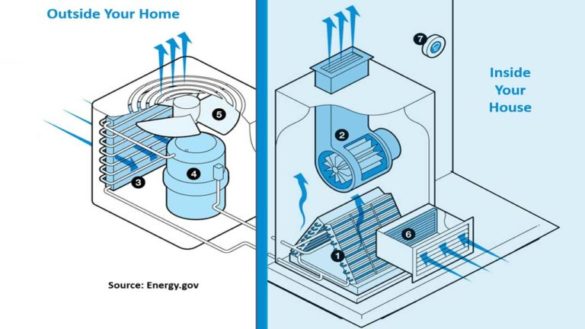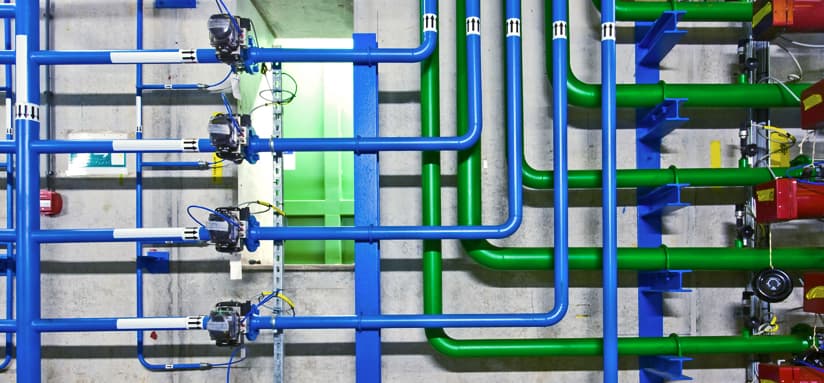What are your thoughts on The Inner Workings of Your Home's Plumbing?

Understanding how your home's plumbing system functions is crucial for every property owner. From supplying tidy water for drinking, food preparation, and showering to safely eliminating wastewater, a properly maintained pipes system is essential for your family members's health and comfort. In this detailed overview, we'll explore the elaborate network that comprises your home's pipes and offer suggestions on upkeep, upgrades, and dealing with usual concerns.
Introduction
Your home's plumbing system is greater than just a network of pipelines; it's a complex system that ensures you have accessibility to clean water and effective wastewater elimination. Knowing its elements and just how they work together can assist you protect against costly repair work and make sure whatever runs smoothly.
Fundamental Elements of a Plumbing System
Pipes and Tubes
At the heart of your plumbing system are the pipes and tubes that lug water throughout your home. These can be made of various products such as copper, PVC, or PEX, each with its benefits in terms of durability and cost-effectiveness.
Components: Sinks, Toilets, Showers, etc.
Components like sinks, toilets, showers, and bath tubs are where water is used in your house. Understanding exactly how these fixtures link to the pipes system helps in detecting problems and preparing upgrades.
Shutoffs and Shut-off Points
Shutoffs control the circulation of water in your plumbing system. Shut-off valves are crucial during emergencies or when you require to make repairs, enabling you to separate parts of the system without disrupting water flow to the whole house.
Water System System
Key Water Line
The main water line connects your home to the local supply of water or an exclusive well. It's where water enters your home and is dispersed to various components.
Water Meter and Pressure Regulator
The water meter actions your water usage, while a pressure regulatory authority guarantees that water moves at a secure stress throughout your home's pipes system, protecting against damages to pipelines and fixtures.
Cold Water vs. Hot Water Lines
Understanding the distinction between cold water lines, which supply water directly from the main, and hot water lines, which carry warmed water from the hot water heater, aids in repairing and preparing for upgrades.
Water drainage System
Drain Pipes Water Lines and Traps
Drain pipelines bring wastewater far from sinks, showers, and bathrooms to the drain or sewage-disposal tank. Catches stop drain gases from entering your home and likewise trap debris that might trigger clogs.
Ventilation Pipes
Ventilation pipelines permit air right into the drain system, avoiding suction that could slow water drainage and create catches to empty. Proper ventilation is crucial for keeping the integrity of your pipes system.
Importance of Correct Drain
Making certain appropriate drainage stops backups and water damages. Frequently cleansing drains and keeping traps can protect against expensive repair services and extend the life of your plumbing system.
Water Heater
Types of Hot Water Heater
Water heaters can be tankless or standard tank-style. Tankless heaters heat water as needed, while containers keep warmed water for immediate usage.
Exactly How Water Heaters Attach to the Plumbing System
Understanding exactly how hot water heater connect to both the cold water supply and warm water circulation lines assists in detecting issues like inadequate warm water or leaks.
Upkeep Tips for Water Heaters
Regularly flushing your hot water heater to get rid of sediment, examining the temperature level setups, and inspecting for leaks can prolong its life-span and improve energy effectiveness.
Usual Plumbing Problems
Leakages and Their Causes
Leaks can happen as a result of aging pipes, loosened installations, or high water stress. Attending to leakages quickly stops water damages and mold growth.
Blockages and Clogs
Obstructions in drains and bathrooms are commonly brought on by flushing non-flushable products or a build-up of grease and hair. Using drain displays and bearing in mind what drops your drains can prevent blockages.
Indications of Plumbing Problems to Watch For
Low water stress, slow-moving drains pipes, foul odors, or unusually high water bills are signs of potential plumbing issues that must be resolved immediately.
Pipes Maintenance Tips
Routine Inspections and Checks
Schedule annual plumbing evaluations to catch problems early. Seek signs of leaks, deterioration, or mineral build-up in taps and showerheads.
Do It Yourself Upkeep Tasks
Straightforward jobs like cleansing tap aerators, looking for bathroom leaks using dye tablets, or insulating exposed pipelines in chilly environments can stop major plumbing issues.
When to Call a Professional Plumbing
Know when a plumbing problem needs professional experience. Trying complicated repairs without correct understanding can lead to even more damage and higher repair work costs.
Updating Your Pipes System
Factors for Upgrading
Updating to water-efficient components or replacing old pipes can improve water top quality, minimize water expenses, and enhance the value of your home.
Modern Plumbing Technologies and Their Benefits
Explore modern technologies like clever leak detectors, water-saving toilets, and energy-efficient hot water heater that can conserve money and lower ecological influence.
Cost Factors To Consider and ROI
Calculate the in advance prices versus long-term cost savings when thinking about pipes upgrades. Several upgrades pay for themselves via lowered utility bills and less repair work.
Environmental Influence and Conservation
Water-Saving Fixtures and Devices
Setting up low-flow faucets, showerheads, and commodes can substantially reduce water usage without giving up performance.
Tips for Reducing Water Use
Easy behaviors like repairing leakages quickly, taking much shorter showers, and running full tons of washing and dishes can save water and reduced your utility expenses.
Eco-Friendly Plumbing Options
Take into consideration sustainable plumbing products like bamboo for floor covering, which is durable and environmentally friendly, or recycled glass for kitchen counters.
Emergency situation Preparedness
Actions to Take During a Pipes Emergency
Know where your shut-off shutoffs are located and exactly how to switch off the water system in case of a burst pipe or major leak.
Relevance of Having Emergency Situation Contacts Helpful
Maintain get in touch with details for regional plumbing professionals or emergency solutions readily available for fast reaction throughout a pipes crisis.
Do It Yourself Emergency Situation Fixes (When Appropriate).
Short-term solutions like using air duct tape to spot a leaking pipe or positioning a bucket under a leaking tap can minimize damage till a professional plumbing arrives.
Final thought.
Recognizing the anatomy of your home's plumbing system equips you to preserve it properly, saving money and time on repairs. By following regular maintenance regimens and remaining informed about contemporary plumbing innovations, you can guarantee your pipes system operates successfully for years to find.
Understanding Your Home Plumbing System: A Comprehensive Guide
Plumbing System: The Lifeline of Your Home
At its core, the plumbing system is designed to perform two primary functions: bring fresh water into your home and remove wastewater. The system is a network of pipes, fixtures, and other components that transport water and sewage. Residential plumbing systems include potable water supply lines, drain-waste-vent (DWV) systems, and various plumbing fixtures that make water use in daily tasks possible.
Key Components:
Water Supply: This part of your plumbing system brings municipal water into your home, passing through the main water supply line. It s responsible for supplying all water needs, from drinking to bathing.
Drainage System: It carries waste and water away from your home to the sewer or septic system. This system includes all the piping within your home that leads to external sewage or septic systems.
Vent System: An essential yet often overlooked component, the vent system allows sewer gases to escape and lets air into the drainpipes, ensuring water and waste move correctly through the system.
Fixture: More Than Just Taps and Toilets
Plumbing fixtures are the most interactive parts of the plumbing system, including faucets, showers, toilets, and sinks. Each fixture is connected to the plumbing system and plays a role in either the delivery of freshwater or the disposal of waste and wastewater.
Types of Fixtures:
Faucets and Sinks: Used for washing hands, dishes, and other daily water needs.
Toilets: Dispose of human waste through the sewage system.
Bathtubs and Showers: Provide bathing facilities, requiring both hot and cold water supply.
Water Supply: The Source of Life
The water supply system is a critical component, ensuring that potable water is available throughout your home for various uses, including drinking, cooking, and cleaning. This system consists of pipes that distribute water to different parts of the house, controlled by valves to regulate the water flow.
Types of Plumbing: Materials and Methods
Various types of plumbing systems and materials are used in residential settings, each with its advantages and applications. From copper and PVC pipes for water supply to cast iron and ABS for drainage, the choice of materials can impact the longevity and efficiency of your plumbing system.
https://intownplumbingtx.com/articles/home-plumbing-system-guide/

Understanding Your Home Plumbing System: A Comprehensive Guide
Plumbing System: The Lifeline of Your Home
At its core, the plumbing system is designed to perform two primary functions: bring fresh water into your home and remove wastewater. The system is a network of pipes, fixtures, and other components that transport water and sewage. Residential plumbing systems include potable water supply lines, drain-waste-vent (DWV) systems, and various plumbing fixtures that make water use in daily tasks possible.
Key Components:
Water Supply: This part of your plumbing system brings municipal water into your home, passing through the main water supply line. It s responsible for supplying all water needs, from drinking to bathing.
Drainage System: It carries waste and water away from your home to the sewer or septic system. This system includes all the piping within your home that leads to external sewage or septic systems.
Vent System: An essential yet often overlooked component, the vent system allows sewer gases to escape and lets air into the drainpipes, ensuring water and waste move correctly through the system.
Fixture: More Than Just Taps and Toilets
Plumbing fixtures are the most interactive parts of the plumbing system, including faucets, showers, toilets, and sinks. Each fixture is connected to the plumbing system and plays a role in either the delivery of freshwater or the disposal of waste and wastewater.
Types of Fixtures:
Water Supply: The Source of Life
The water supply system is a critical component, ensuring that potable water is available throughout your home for various uses, including drinking, cooking, and cleaning. This system consists of pipes that distribute water to different parts of the house, controlled by valves to regulate the water flow.
Types of Plumbing: Materials and Methods
Various types of plumbing systems and materials are used in residential settings, each with its advantages and applications. From copper and PVC pipes for water supply to cast iron and ABS for drainage, the choice of materials can impact the longevity and efficiency of your plumbing system.
https://intownplumbingtx.com/articles/home-plumbing-system-guide/
I am just very interested by and I am hoping you liked the article. Feel free to pause to promote this post if you liked it. We take joy in reading our article about .
About This